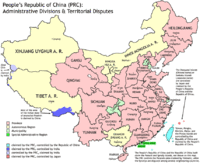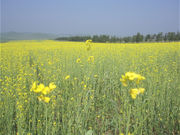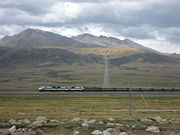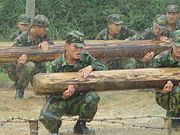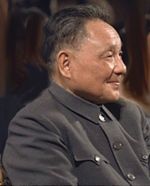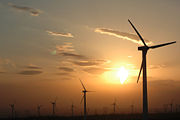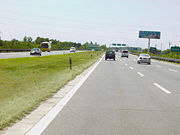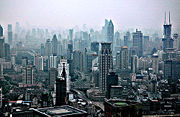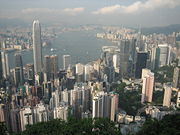People's Republic of China
2008/9 Schools Wikipedia Selection. Related subjects: Asia; Asian Countries
| 中华人民共和国 ( simplified Chinese characters) 中華人民共和國 ( traditional Chinese characters) Zhōnghuá Rénmín Gònghéguó People's Republic of China
|
||||||
|---|---|---|---|---|---|---|
|
||||||
| Anthem: March of the Volunteers (义勇军进行曲) |
||||||
|
|
||||||
| Capital | Beijing |
|||||
| Largest city | Shanghai | |||||
| Official languages | Mandarin1 | |||||
| Demonym | Chinese | |||||
| Government | Socialist Republic² | |||||
| - | President | Hu Jintao | ||||
| - | Premier | Wen Jiabao | ||||
| Establishment | ||||||
| - | People's Republic declared |
October 1, 1949 |
||||
| Area | ||||||
| - | Total | 9,598,086 km² or 9,640,821 km²*4( 3rd / 4th–disputed³) 3,704,427 sq mi |
||||
| - | Water (%) | 2.8³ | ||||
| Population | ||||||
| - | 2007 estimate | 1,321,851,888³ ( 1st) | ||||
| - | 2000 census | 1,242,612,226 | ||||
| - | Density | 140/km² ( 53rd) 363/sq mi |
||||
| GDP ( PPP) | 2006 estimate | |||||
| - | Total | $10.21 trillion ( 2nd) | ||||
| - | Per capita | $8,788 ( 82nd) | ||||
| GDP (nominal) | 2007 estimate | |||||
| - | Total | $2.6 trillion ( 4th) | ||||
| - | Per capita | $2,800 ( 101th) | ||||
| Gini (2002) | 44 (medium) | |||||
| HDI (2007) | ▲ 0.777 (medium) ( 81st) | |||||
| Currency | Yuan ( CNY) |
|||||
| Time zone | ( UTC+8) | |||||
| - | Summer ( DST) | not observed ( UTC+8) | ||||
| Internet TLD | .cn³ | |||||
| Calling code | +86³ | |||||
| 1 | General Information of the People's Republic of China, ChinaToday. Retrieved 21 February 2007. In addition to Mandarin, Cantonese is co-official in both Hong Kong and Macau. English is co-official in Hong Kong (SAR); correspondingly, Portuguese in Macau (SAR). Similarly, several minority languages are also co-official with Chinese (Mandarin) in minority areas, viz. Zhuang in Guangxi, Uyghur in Xinjiang, Mongolian in the classical alphabet in Inner Mongolia, Tibetan in Tibet, and Korean in Yanbian, Jilin. | |||||
| 2 | The role of the government, China, Encyclopaedia Britannica. Retrieved on 21-02-2007. | |||||
| 3 | Information for mainland China only. The Special Administrative Regions of the PRC: Hong Kong, Macau are excluded. In addition, the island territories under the control of the Republic of China, which includes the islands of (Taiwan, Kinmen, and Matsu) are also excluded. | |||||
| 4 | 9,598,086 km² Excludes all disputed territories. 9,640,821 km² Includes PRC-administered area ( Aksai Chin and Trans-Karakoram Tract, both territories claimed by India), Taiwan is not included. |
|||||
The People's Republic of China ( simplified Chinese: 中 华 人 民 共 和 国; traditional Chinese: 中 華 人 民 共 和 國; pinyin: Zhōnghuá Rénmín Gònghéguó listen ), commonly known as China, is the largest country in East Asia and the third or fourth largest country in the world. With a population of over 1.3 billion, roughly one-fifth of the world's total population, it is the most populous country in the world. Its capital is Beijing.
The Communist Party of China (CPC) has led the PRC under a single-party system since the state's establishment in 1949. The PRC is involved in a long-running dispute over the political status of Taiwan. The CPC's rival during the Chinese Civil War, the Kuomintang (KMT), retreated to Taiwan and surrounding islands after its civil war defeat in 1949, claiming legitimacy over China, Mongolia, and Tuva while it was the ruling power of the Republic of China (ROC). The term " Mainland China" is often used to denote the areas under PRC rule, but sometimes excludes its two Special Administrative Regions: Hong Kong and Macau.
Because of its vast population, rapidly growing economy, large research and development investments, China is often considered as an emerging superpower. It has the world's fourth largest economy and second largest purchasing power parity. China is also a permanent member of the United Nations Security Council and Asia-Pacific Economic Cooperation. Since 1978, China's market-based economic reforms have helped lift over 400 million Chinese out of poverty, bringing down the poverty rate from 53% of population in 1981 to 8% by 2001. However, China is now faced with a number of other economic problems, including an aging population and an increasing rural-urban income gap.
China plays a major role in international trade. The country is the world's largest consumer of steel and concrete, using, respectively, a third and over a half of the world's supply of each. It is also the world's second largest importer of petroleum. Counting all products, China is the third largest importer and the second largest exporter in the world.
History
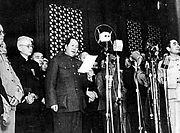
Major combat in the Chinese Civil War ended in 1949 with the Communist Party of China in control of the mainland, and the Kuomintang retreating to Taiwan and some outlying islands of Fujian. On October 1, 1949 Mao Zedong proclaimed the People's Republic of China, declaring "the Chinese people have stood up". Red China was a frequent appellation for the PRC (generally within the Western bloc) used from the time of Communist ascendance until the mid-late 1970s with the improvement of relations between China and the West.
Following a series of dramatic economic failures (caused by the Great Leap Forward), Mao stepped down from his position as chairman in 1959, with Liu Shaoqi as successor. Mao still had much influence over the Party, but was removed from day-to-day management of economic affairs, which came under the control of Liu Shaoqi and Deng Xiaoping.
In 1966, Mao and his allies launched the Cultural Revolution, which would last until Mao's death a decade later. The Cultural Revolution, motivated by power struggles within the Party and a fear of the Soviet Union, led to a major upheaval in Chinese society. In 1972, at the peak of the Sino-Soviet split, Mao and Zhou Enlai met Richard Nixon in Beijing to establish relations with the United States. In the same year, the PRC was admitted to the United Nations, replacing the Republic of China for China's membership of the United Nations, and permanent membership of the Security Council.
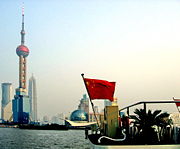
After Mao's death in 1976 and the arrest of the Gang of Four, blamed for the excesses of the Cultural Revolution, Deng Xiaoping quickly wrestled power from Mao's anointed successor Hua Guofeng. Although Deng never became the head of the Party or State himself, his influence within the Party led the country to economic reforms of significant magnitude. The Communist Party subsequently loosened governmental control over citizens' personal lives and the communes were disbanded with many peasants receiving multiple land leases, which greatly increased incentives and agricultural production. This turn of events marked China's transition from a planned economy to a mixed economy with an increasingly open market environment, a system termed by many " market socialism". The PRC adopted its current constitution on December 4, 1982.
In 1989, the death of pro-reform official, Hu Yaobang, helped to spark the Tiananmen Square protests of 1989, during which students and others campaigned for several months for more democratic rights and freedom of expression. However, they were eventually put down on June 4 when PLA troops and vehicles entered and forcibly cleared the square by opening fire on protesters, resulting in numerous casualties. This event was widely reported and famously videotaped, which brought worldwide condemnation and sanctions against the government.
President Jiang Zemin and Premier Zhu Rongji, both former mayors of Shanghai, led post-Tiananmen China in the 1990s. Under Jiang Zemin's ten years of administration, China's economic performance pulled an estimated 150 million peasants out of poverty and sustained an average annual GDP growth rate of 11.2%. The country formally joined the World Trade Organization in 2001.
Although China needs economic growth to spur its development, the government has begun to worry that rapid economic growth has negatively impacted the country's resources and environment. Another concern is that certain sectors of society are not sufficiently benefiting from China's economic development. As a result, under current President Hu Jintao and Premier Wen Jiabao, the PRC have initiated policies to address these issues of equitable distribution of resources, but the outcome remains to be seen. For much of China's population, living standards have seen extremely large improvements, and freedom continues to expand, but political controls remain tight.
Politics
While the PRC is regarded as a Communist state by many political scientists, simple characterizations of China's political structure since the 1980s are no longer possible. The PRC government has been variously described as authoritarian, communist, and socialist, with heavy restrictions remaining in many areas, most notably in the Internet and in the press, freedom of assembly, freedom of reproductive rights, and freedom of religion. However, compared to its closed door policies until the mid-1970s, the liberalization of the PRC is such that the administrative climate is much less restrictive than before, though the PRC is still far from the full-fledged democracy practiced in most of Europe or North America, according to most observers internationally.
The country is ruled under the Constitution of the People's Republic of China. Its incumbent President is Hu Jintao and its premier is Wen Jiabao.
The country is run by the Communist Party of China (CPC), which is guaranteed power by the Constitution. There are other political parties in the PRC, referred to in China as "democratic parties", which participate in the People's Political Consultative Conference and the National People's Congress. There have been some moves toward political liberalization, in that open contested elections are now held at the village and town levels, and that legislatures have shown some assertiveness from time to time. However, the Party retains effective control over governmental appointments: in the absence of meaningful opposition, the CPC wins by default most of the time. Political concerns in China include lessening the growing gap between rich and poor and fighting corruption within the government leadership. The level of support that the Communist Party of China has among the Chinese population in general is unclear since there are no consistently contested national elections. According to a survey conducted in Hong Kong, where a relatively high level of freedom is enjoyed, the current CPC leaders have received substantial votes of support when residents were asked to rank their favourite leaders from the PRC and Taiwan.
Foreign relations

The People's Republic of China maintains diplomatic relations with most major countries in the world. Sweden was the first western country to establish diplomatic relations with China on 9th May 1950. In 1971, the PRC replaced the Republic of China as the sole representative of China in the United Nations and as one of the five permanent members of the United Nations Security Council. It is considered a founding member of the UN, though the PRC was not in control of China at the time. The PRC was also a former member and leader of the Non-Aligned Movement.
Under the One-China policy, the PRC has made it a precondition to establishing diplomatic relations that the other country acknowledges its claim to Taiwan and sever official ties with the Republic of China (ROC) government. The government opposes publicized foreign travels by former and present Taiwanese officials promoting Taiwanese Independence, such as Lee Teng-hui and Chen Shui-bian, and other politically controversial figures, such as Tenzin Gyatso, the Dalai Lama of Tibet, in an official context.
China has been playing an increasing role in calling for free trade areas and security pacts amongst its Asia-Pacific neighbors. In 2004, China proposed an entirely new East Asia Summit (EAS) framework as a forum for regional security issues that pointedly excluded the United States. The EAS, which includes ASEAN Plus Three, India, Australia and New Zealand, held its inaugural summit in 2005. China is also a founding member of the Shanghai Cooperation Organization (SCO), with Russia and the Central Asian republics.
Much of the current foreign policy is based on the concept of China's peaceful rise. Conflicts with foreign countries have occurred at times in its recent history, particularly with the United States; e.g., the U.S. bombing of the Chinese embassy in Belgrade during the Kosovo conflict in May 1999 and the U.S.-China spy plane incident in April 2001. Its foreign relations with many Western nations suffered for a time following the Tiananmen Square Protests of 1989, though they have since recovered. The relationship between China and Japan has been strained at times by Japan's refusal to acknowledge its war-time past to the satisfaction of the PRC, e.g. revisionist comments made by prominent Japanese officials and in some Japanese history textbooks. Another point of conflict between the two countries is the frequent visits by Japanese government officials to the Yasukuni Shrine. However, Sino-Japanese relations have warmed considerably since Shinzo Abe became the new Japanese Prime Minister in September 2006. A joint historical study to be completed by 2008 of WWII atrocities is being conducted by China and Japan.
Equally bordering the most countries in the world alongside Russia, the PRC was in a number of international territorial disputes. China's territorial disputes have led to localized wars in the last 50 years, including the Sino-Indian War in 1962, the Sino-Soviet border conflict in 1969 and the Sino-Vietnam War in 1979. In 2001, the PRC and Russia signed the Treaty of Good-Neighborliness and Friendly Cooperation, which paved the way in 2004 for Russia to transfer Yinlong Island as well as one-half of Heixiazi Island to China, ending a long-standing Sino-Russian border dispute. Other territorial disputes include islands in the East and South China Seas, and undefined or disputed borders with India, Tajikstan and North Korea.
While accompanying a rapid economic rise, the PRC since the 1990s seeks to maintain a policy of quiet diplomacy with its neighbors. Steadying its economic growth and participating in regional organizations and cultivating bi-lateral relations will ease suspicion over China's burgeoning military capabilities. The PRC has started a policy of wooing African nations for trade and bilateral co-operations.
Population policy
With a population of over 1.3 billion, the PRC is very concerned about its population growth and has attempted, with mixed results, to implement a strict family planning policy. The government's goal is one child per family, with exceptions for ethnic minorities and flexibility in rural areas, where a family can have a second child if the first is a girl or physically disabled. The government's goal is to stabilize population growth early in the twenty-first century, though some projections estimate a population of anywhere ranging from 1.4 billion to 1.6 billion by 2025.
The policy is resisted, particularly in rural areas, because of the need for agricultural labour and a traditional preference for boys. Families who breach the policy often lie during the census. Official government policy opposes forced abortion or sterilization, but allegations of coercion continue as local officials, who are faced with penalties for failing to curb population growth, may resort to forced abortion or sterilization, or manipulation of census figures.
The decreasing reliability of PRC population statistics since family planning began in the late 1970s has made evaluating the effectiveness of the policy difficult. Estimates by Chinese demographers of the average number of children for a Chinese woman vary from 1.5 to 2.0. The government is particularly concerned with the large imbalance in the sex ratio at birth, apparently the result of a combination of traditional preference for boys, family planning pressure, and the wide availability of ultrasound, which led to its ban for the purpose of preventing sex-selective abortion.
Human rights
The Constitution of the People's Republic of China states that the "fundamental rights" of citizens include freedom of speech, freedom of the press, the right to a fair trial, freedom of religion, universal suffrage, and property rights. However, censorship of political speech and information is openly and routinely used to protect what the government considers national security interests. In particular, press control is notoriously tight: Reporters Without Borders considers the PRC one of the least free countries in the world for the press. The government has a policy of limiting some protests and organizations that it considers a threat to social stability and national unity, as was the case with the Tiananmen Square protests of 1989. The Communist Party has had mixed success at controlling information: a very strong media control system faces very strong market forces, an increasingly educated citizenry and cultural change that are making China more open. In some cases, especially on environmental issues, China's leaders see expressions of public dissatisfaction as a catalyst for positive change.
Certain foreign governments and NGOs routinely criticise the PRC, alleging widespread human rights violations including systematic use of lengthy detention without trial, forced confessions, torture, mistreatment of prisoners, restrictions of freedom of speech, assembly, association, religion, the press, and workers' rights. China leads the world in capital punishment, accounting for roughly 90% of total death-penalty executions in 2004. Human rights issues are one of the factors driving independence movements in Tibet and Xinjiang. In the Reporters Without Borders' Annual World Press Freedom Index of 2005, the PRC ranked 159 out of 167 places. PRC journalist He Qinglian in her 2004 book Media Control in China documents government controls on the Internet and other media in China.
The PRC government responds to these criticisms by arguing that the notion of human rights should factor in standards of living; rise in the standard of living for some Chinese is seen as an indicator of improvement in human rights.
Political divisions
The People's Republic of China has administrative control over twenty-two provinces and considers Taiwan to be its twenty-third province. There are also five autonomous regions, each with a designated minority group; four municipalities; and two Special Administrative Regions that enjoy considerable autonomy. The twenty-two provinces, five autonomous regions and four municipalities can be collectively referred to as " mainland China", a term which usually excludes Hong Kong and Macau.
|
|
|
|||||
|---|---|---|---|---|---|---|
| For a larger map, see here. |
|
|
|
|
|
|
| †Taiwan is claimed by the PRC but administered by the Republic of China | ||||||
|
|
|
Regions (特别行政区) |
||||
|
||||||
Geography and climate
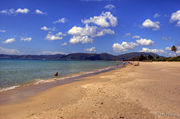
China is the second largest country in Asia by area after Russia, and is considered the third or fourth largest in the world by the U.S. Central Intelligence Agency in respect to land-and-sea area. The uncertainty over size is related to the validity of claims by the PRC on territories such as Aksai Chin and Trans-Karakoram Tract (both territories also claimed by India), and a recent change in the method used by the United States to calculate its surface area. It borders 14 nations (counted clockwise from south): Vietnam, Laos, Myanmar (Burma), India, Bhutan, Nepal, Pakistan, Afghanistan, Tajikistan, Kyrgyzstan, Kazakhstan, Russia, Mongolia and North Korea. Additionally the border between PRC and ROC is located in territorial waters.
The territory of the PRC contains a large variety of landscapes. In the east, along the shores of the Yellow Sea and the East China Sea, there are extensive and densely populated alluvial plains, while on the edges of the Inner Mongolian plateau in the north, grasslands can be seen. Southern China is dominated by hill country and low mountain ranges. In the central-east are the deltas of China's two major rivers, the Huang He and Yangtze River (Chang Jiang). Other major rivers include the Xijiang River, Mekong, Brahmaputra and Amur.
To the west, major mountain ranges, notably the Himalayas, with China's highest point at the eastern half of Mount Everest, and high plateaus feature among the more arid landscapes such as the Taklamakan and the Gobi Desert.
A major issue is the continued expansion of deserts, particularly the Gobi Desert. Although barrier tree lines planted since the 1970s have reduced the frequency of sandstorms, prolonged drought and poor agricultural practices result in dust storms plaguing northern China each spring, which then spread to other parts of East Asia, including Korea and Japan. Water, erosion, and pollution control have become important issues in China's relations with other countries.
China has some relevant environmental regulations: the 1979 Environmental Protection Law, which was largely modelled on U.S. legislation. But the environment continues to deteriorate. While the regulations are fairly stringent, they are frequently disregarded by local communities while seeking economic development. Twelve years after the law, only one Chinese city was making an effort to clean up its water discharges. This indicates that China is about twenty years behind the U.S. schedule of environmental regulation.
Water pollution has increased as an issue along with industrial production. The Chinese government has chosen a discharge standard measuring the concentration of a pollutant rather than the total pollutant load (as is done in the U.S. and many Western countries). As a result many industrial dischargers in China simply dilute the effluent with river water taken from the same source as the receiving waters. Consequently the outcome has been to create considerable water pollution in many of the country's rivers.
With regard to carbon emissions, China has ratified the Kyoto Protocol but it is not required to reduce carbon emissions because of its status as a developing country. However, with rapid industrialisation, China is fast becoming one of the world's top emitters of carbon gases and possibly a major contributor to global warming.
Part of the price China is paying for increased prosperity is damage to the environment. Leading Chinese environmental campaigner Ma Jun has warned that water pollution is one of the most serious threats facing China. According to Ma the drinking water of 300 million peasants is unsafe and water quality in one fifth of the cities is not up to standard. This makes the crisis of water shortages more pressing, with 400 out of 600 cities short of water.
Military
With 2.3 million active troops, the People's Liberation Army (PLA) is the largest military in the world. The PLA consists of an army, navy, air force, and strategic nuclear force. The official announced budget of the PLA for 2007 was $45 billion. However, the United States claims China does not report its real military spending. The DIA estimates that the real Chinese military budget for 2007 could be anywhere from US$85 to US$125 billion.
The PRC, despite possession of nuclear weapons and delivery systems, is widely seen by military researchers both within and outside of China as having only limited power projection capability; this is, among other things, because of the limited effectiveness of its navy. It is considered a major regional power and possibly an emerging superpower.
Much progress has been made in the last decade and the PRC continues to make efforts to modernize its military. It has purchased state-of-the-art fighter jets from Russia, such as the Su-30s, and has also produced its own modern fighters, specifically the Chinese J-10s and the J-11s. It has also acquired and improved upon the Russian S-300 surface-to-air missile systems, which are considered to be among the best aircraft-intercepting systems in the world, albeit Russia has since produced the new generation S-400 Triumf. The PRC's armoured and rapid-reaction forces have been updated with enhanced electronics and targeting capabilities. In recent years, much attention has been focused on building a navy with blue-water capability.
Economy
Beginning in late 1978, the Chinese leadership has been reforming the economy from a Soviet-style centrally planned economy to a more market-oriented economy that is still within a rigid political framework under Party control. The reforms replaced collectivization of Chinese agriculture with privatization of farmlands, increased the responsibility of local authorities and industry managers, allowed a wide variety of small-scale enterprises to flourish, and promoted foreign investment. Price controls were also relaxed. These changes resulted in mainland China's shift from a planned economy to a mixed economy.
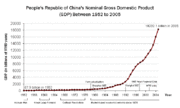
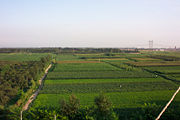
China became a member of the World Trade Organization in 2001. China’s accession into the World Trade Organization (WTO) was a goal achieved after nearly fifteen years of exhausting negotiations carrying many legal, political and social implications for all parties. China was finally able to convince WTO members that without China, the WTO is only partially a worldwide trade organization. The road to the signature of the final agreement of accession was long, but these difficulties pale in comparison to the problems that have not yet been tackled in terms of achieving real implementation of its provisions throughout the territory of the People’s Republic of China (PRC). China’s accession surely presents the world trading system with opportunities, but also poses the challenge of integrating a market with strong structural, behavioural and cultural constraints.
The government emphasizes personal income and consumption by introducing new management systems to help increase productivity. The government also focuses on foreign trade as a major vehicle for economic growth, which led to 5 Special Economic Zones (SEZ: Shenzhen, Zhuhai, Shantou, Xiamen, Hainan Province) where investment laws are relaxed so as to attract foreign capital. Since the 1990s, SEZs and similar concepts have been expanded to major Chinese cities, including Shanghai and Beijing. The result has been a 6-fold increase of GDP since 1978. Chinese economic development is among the fastest in the world, and has been growing at an average annual GDP rate of 9.4% for the past 25 years. At the end of 2005, the PRC became the fourth largest economy in the world by exchange rate, and the second largest in the world after the United States by purchasing power parity at US$8,158 trillion. But with its large population this still gives an average GDP per person of only an estimated US$8,000 (2006), about 1/5th that of the United States.
Mainland China has a reputation as being a low-cost manufacturer, which caused notable disputes in global markets. This is largely because Chinese corporations can produce many products far more cheaply than other parts of Asia or Latin America, and because expensive products produced in developed countries like the United States are in large part uncompetitive compared to European or Asian goods. Another factor is the unfavorable exchange rate between the Chinese yuan and the United States dollar to which it was pegged.
On July 21, 2005 the People's Bank of China announced that it would move to a floating peg, allowing its currency to move against the United States dollar by 0.5% (effective 18 May 2007, which was earlier 0.3%) a day, while 3% a day against other currencies. Many high-tech American companies have difficulty exporting to China because of U.S. federal government restrictions, which exacerbated the trade gap between the PRC and the US, widespread software piracy and illegal copying of intellectual property (a major US export), and perceived low quality of US goods. On the other hand, China runs a trade deficit with Taiwan and South Korea, importing more from those nations than exports. China runs a large but diminishing trade surplus with Japan (slight deficit if Hong Kong is included).
There has been a significant rise in the Chinese standard of living in recent years. Today, a rapidly declining 10 percent of the Chinese population is below the poverty line. 90.9% of the population is literate, compared to 20% in 1950. The life expectancy in China is the third highest in East Asia, after Japan and South Korea. There is a large wealth disparity between the coastal regions and the remainder of the country. To counter this potentially destabilizing problem, the government has initiated the China Western Development strategy (2000), the Revitalize Northeast China initiative (2003), and the Rise of Central China policy (2004), which are all aimed at helping the interior of China to catch up.
China is undergoing major reforms in its financial sector, which has been plagued by nonperforming loans made in the 1980s and early 1990s to inefficient state-owned enterprises. The government has spent five years and more than US$400 billion cleaning bad loans off the books of the big four state-owned banks, helping prepare them to become shareholder corporations. By the end of 2006, China had restructured three of its four largest banks and listed them publicly. China's largest bank, the Industrial and Commercial Bank of China (ICBC) in October 2006 raised US$21.6 billion in the world's largest initial public offering (IPO) in history. ICBC is now the world's second largest bank in market value, after only Citibank. These highly successful IPOs have helped ease the government's burden and spur further structural reforms in China's nascent banking industry.
Science and technology
After the Sino-Soviet split, China started to develop its own nuclear weapons and delivery systems, successfully detonating its first surface nuclear test in 1964 at Lop Nor. A natural outgrowth of this was a satellite launching program, which culminated in 1970 with the launching of Dongfang Hong I, the first Chinese satellite. This made the PRC the fifth nation to independently launch a satellite. In 1992, the Shenzhou manned spaceflight program was authorized. After four tests, Shenzhou 5 was launched on October 15, 2003, using a Long March 2F rocket and carrying Chinese astronaut Yang Liwei, making the PRC the third country to put a human being into space through its own endeavors. With the successful completion of the second manned mission, Shenzhou 6 in October 2005, the country plans to build a Chinese Space Station in the near future and achieve a lunar landing in the next decade.
China has the world's second largest research and development budget, and is expected to invest over $136 billion this year after growing more than 20% in the past year. The Chinese government continues to place heavy emphasis on research and development by creating greater public awareness of innovation, and reforming financial and tax systems to promote growth in cutting-edge industries. President Hu Jintao in January 2006 called for China to make the transition from a manufacturing-based economy to an innovation-based one, and this year's National People's Congress has approved large increases in research funding. Stem-cell research and gene therapy, which some in the Western world see as controversial, face minimal regulation in China. China has an estimated 926,000 researchers, second in number only to the 1.3 million in the United States.
China is also actively developing its software, semiconductor and energy industries, including renewable energies such as hydro, wind and solar power. In an effort to reduce pollution from coal-burning power plants, China has been pioneering the deployment of pebble bed nuclear reactors, which run cooler and safer, and have potential applications for the hydrogen economy.
Transportation
Transportation in the mainland of the People's Republic of China has improved remarkably since the late 1990s as part of a government effort to link the entire nation through a series of expressways known as the National Trunk Highway System (NTHS). The total length of expressway is 45,000 km at the end of 2006, second only to the United States.
Private car ownership is increasing at an annual rate of 15%, though it is still uncommon because of government policies that make car ownership expensive, such as taxes and toll roads.
Air travel has increased, but remains too expensive for most. Long distance transportation is still dominated by railways and charter bus systems. The railways are still the vital carrier in China, and until this year steam locomotives were still a common sight. It is thought that some are still in use, especially on industrial networks.
Cities such as Beijing and Shanghai are building subways or light rail systems. Hong Kong has one of the most developed transport systems in the world. Shanghai already has a Maglev system connecting downtown Shanghai to Pudong International Airport
Demographics
As of July 2006, there are 1,313,973,713 people in the PRC. About 20.8% (male 145,461,833; female 128,445,739) are 14 years old or younger, 71.4% (male 482,439,115; female 455,960,489) are between 15 and 64 years old, and 7.7% (male 48,562,635; female 53,103,902) are over 65 years old. The population growth rate for 2006 is 0.59%. The PRC officially recognizes 56 distinct ethnic groups, the largest of which are the Han Chinese, who constitute about 91.9% of the total population. Large ethnic minorities include the Zhuang (16 million), Manchu (10 million), Hui (9 million), Miao (8 million), Uyghur (7 million), Yi (7 million), Tujia (5.75 million), Mongols (5 million), Tibetans (5 million), Buyi (3 million), and Koreans (2 million).
In the past decade, China's cities expanded at an average rate of 10% annually. The country's urbanization rate increased from 17.4% to 41.8% between 1978 and 2005, a scale unprecedented in human history. 80 to 120 million migrant workers work part-time in the major cities and return home to the countryside periodically with their earnings.
Today, the People's Republic of China has dozens of major cities with one million or more long-term residents, including the three global cities of Beijing, Hong Kong, and Shanghai. Major cities in China play key roles in national and regional identity, culture and economics.
Largest cities
The figures below are the 2001 estimates for the ten largest urban populations within administrative city limits; a different ranking exists when considering the total municipal populations (which includes suburban and rural populations). The large floating populations of migrant workers make conducting censuses in urban areas difficult; the figures below do not include the floating population, only long-term residents.
| Rank | City urban area | Type/location | Population (2001 est) millions |
Density (2001 est) per km² |
Municipality limits (2000 census) |
Region | |
|---|---|---|---|---|---|---|---|
| millions | density (/km²) | ||||||
| 1 | Shanghai | municipality | 9.838 | 34,700 | 16.74 | 2,640 | East |
| 2 | Beijing | municipality | 7.441 | 29,800 | 13.82 | 822 | North |
| 3 | Hong Kong | SAR | 6.112 | 76,200 | 7.01 | 6,294 | South Central |
| 4 | Tianjin | municipality | 5.095 | 10,500 | 10.01 | 803 | North |
| 5 | Wuhan | Hubei province | 4.489 | 12,950 | 8.31 | 947 | South Central |
| 6 | Guangzhou | Guangdong province | 4.155 | 11,600 | 10.15 | 1,337 | South Central |
| 7 | Shenyang | Liaoning province | 3.981 | 9,250 | 7.20 | 557 | Northeast |
| 8 | Chongqing | municipality | 3.934 | 23,500 | 30.90 | 378 | Southwest |
| 9 | Nanjing | Jiangsu province | 2.822 | 13,250 | 6.40 | 970 | East |
| 10 | Harbin | Heilongjiang province | 2.672 | 11,350 | 9.35 | 174 | Northeast |
Education
In 1986, China set the long-term goal of providing compulsory nine-year basic education to every child. As of 1997, there were 628,840 primary schools, 78,642 secondary schools and 1,020 higher education institutions in the PRC. In February 2006, the government advanced its basic education goal by pledging to provide completely free nine-year education, including textbooks and fees, in the poorer western provinces. As of 2002, 90.9% (male: 95.1%; female: 86.5%) of the population over age 15 are literate. China's youth (age 15 to 24) literacy rate is 98.9% (99.2% for males and 98.5% for females) in 2000. In March 2007, China announced the decision of making education a national "strategic priority", the central budget of the national scholarships will be tripled in two years and 223.5 billion Yuan (28.65 billion US dollars) of extra funding will be allocated from the central government in the next 5 years to improve the compulsory education in rural areas.
The quality of Chinese colleges and universities varies considerably across the country. The consistently top-ranked universities in mainland China are Peking and Tsinghua in Beijing; Fudan and Shanghai Jiaotong University in Shanghai; Xi'an Jiaotong University in Xi'an; Nanjing University in Nanjing; the University of Science and Technology of China in Hefei; Zhejiang University in Hangzhou and Wuhan University in Wuhan.
Many parents are highly committed to their children's education, often investing large portions of the family's income on education. Private lessons and recreational activities, such as in foreign languages or music, are popular among the middle-class families who can afford them.
Public health
The Ministry of Health, together with its counterparts in the provincial health bureaus, oversees the health needs of the Chinese population. An emphasis on public health and preventative treatment characterized health policy since the early 1950s. At that time, the party started the Patriotic Health Campaign, which was aimed at improving sanitation and hygiene, as well as attacking several diseases. This has shown major results as diseases like cholera, typhoid, and scarlet fever were nearly eradicated.
With economic reform after 1978, the health of the Chinese public improved rapidly because of better nutrition despite the disappearance, along with the People's Communes, of much of the free public health services provided in the countryside. Health care in China became largely private fee-for-service. By 2000, when the World Health Organization made a large study of public health systems throughout the world, The World Health Report 2000 Health Systems: Improving Performance the Chinese public health system ranked 144 of the 191 UN member states ranked.
The country's life expectancy jumped from about 41 years in 1950 to almost 73 years in 2006, and infant mortality went down from 300 per thousand in the 1950s to about 23 per thousand in 2006. Malnutrition as of 2002 stood at 12 percent of the population according to United Nations FAO sources.
Despite significant improvements in health and the introduction of western style medical facilities, the PRC has several emerging public health problems, which include respiratory problems as a result of widespread air pollution and millions of cigarette smokers, a possible future HIV/AIDS epidemic, and an increase in obesity among urban youths. Estimates of excess deaths in China from environmental pollution (apart from smoking) are placed at 760,000 people per annum from air and water pollution (including indoor air pollution) China's large population and close living quarters has led to some serious disease outbreaks in recent years, such as the 2003 outbreak of SARS (a pneumonia-like disease) which has since been largely contained.
Culture
For centuries, opportunity for economic and social advancement in China could be provided by high performance on Imperial examinations. The literary emphasis of the exams affected the general perception of cultural refinement in China, such as the view that calligraphy and literati painting were higher forms of art than dancing or drama. China's traditional values were derived from various versions of Confucianism and conservatism. A number of more authoritarian and rational strains of thought have also been influential, such as Legalism. There was often conflict between the philosophies, such as the individualistic Song Dynasty neo-Confucians, who believed Legalism departed from the original spirit of Confucianism. Examinations and a culture of merit remain greatly valued in China today. In recent years, a number of New Confucians have advocated that democratic ideals and human rights are quite compatible with traditional Confucian "Asian values."
The first leaders of the People's Republic of China were born in the old society but were influenced by the May Fourth Movement and reformist ideals. They sought to change some traditional aspects of Chinese culture, such as rural land tenure, sexism, and a Confucian education, while preserving others, such as the family structure and obedience to the state. Many observers believe that the period following 1949 is a continuation of traditional Chinese dynastic history, while others say that the CPC's rule has damaged the foundations of Chinese culture, especially through political movements such as the Cultural Revolution, where many aspects of traditional culture were labeled 'regressive and harmful' or 'vestiges of feudalism' by the regime. They further argue that many important aspects of traditional Chinese morals and culture, such as Confucianism, Chinese art, literature, and performing arts like Beijing opera, were altered to conform to government policies and propaganda at the time. One example being Chinese character simplification, since traditional characters were blamed for the country's low literacy rate at the time. However, simplified Chinese characters are not used in Taiwan, Hong Kong and Macau.
Today, the PRC government has accepted a great deal of traditional Chinese culture as an integral part of Chinese society, lauding it as an important achievement of the Chinese civilization and emphasizing it as vital to a Chinese national identity. Since the Cultural Revolution has ended, various forms of traditional Chinese art, literature, music, film, fashion and architecture have seen a vigorous revival, and folk and variety art in particular have gained a new found respectability, and sparked interests nation and even worldwide.
Religion
Most Chinese — 59% of the population, or about 767 million people — identify themselves as non-religious. However, rituals and religion — especially the traditional beliefs of Confucianism and Taoism and Buddhism — play a significant part in the lives of many. About 33% of the population follow a mixture of beliefs usually referred to by statisticians as "Traditional Beliefs" or just "Other".
About 8% of the Chinese population are avowed Buddhists, with Mahayana Buddhism (大乘, Dacheng) and its subsets Pure Land (Amidism), Tiantai and Zen being the most widely practiced. With an estimated 100 million adherents, Buddhism is the country's largest organized religion. Other forms of Buddhism, such as Theravada Buddhism and Tibetan Buddhism, are practiced largely by ethnic minorities along the geographic fringes of the Chinese mainland. A government official recently suggested that there are 16 million Christians. However, an independent survey by East China Normal University estimated the Christian population at 40 million, much higher than the government's numbers but much lower than numbers favored by some Western observers. Official figures also indicate that there are about 20 million Muslims.
Sports and recreation
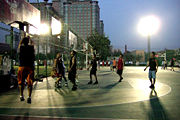
China has one of the oldest sporting cultures in the world, spanning the course of several millennia. There is, in fact, evidence that a form of football (soccer) was first played in China around 1000 AD, leading many historians to believe that the popular sport originated from China. Besides soccer, some of the most popular sports in the country include martial arts, table tennis, badminton, swimming, basketball, and more recently, golf and rugby. Board games such as Go (Weiqi), and Xiangqi (Chinese chess) and recently Chess are also commonly played and have organised competitions.
Physical fitness is widely emphasized in Chinese culture. Morning exercises are a common activity and often one can find the elderly practicing qigong and Tai Chi Chuan in parks or students doing stretches on school campuses. Young people are especially keen on basketball, especially in urban centres with limited space and grass areas. The NBA has a huge following among Chinese youths, with Yao Ming being the idol of many. The 2008 Summer Olympics, officially known as the Games of the XXIX Olympiad, will be held in Beijing, and as a result the country has put even more emphasis on sports.
Many traditional sports are also played. The popular Chinese dragon boat racing (龙舟) occurs during the Duan Wu festival. In Inner Mongolia, sports such as Mongolian-style wrestling and horse racing are popular. In Tibet, archery and equestrian sports are a part of traditional festivals.
- See also: Chinese art, Chinese architecture, Chinese clothing, Chinese cuisine, Chinese medicine, Chinese literature, Chinese mythology, Cinema of China, Chinese animation, Music of China, Public holidays in the People's Republic of China, and List of Chinese people



